TL;DR A no-code voice bot platform solves this problem perfectly. Sarah creates a custom voice bot in 30 minutes. The bot handles all appointment confirmations automatically.
Sarah runs a small dental practice with 500 patients. Her staff spends hours daily calling
patients for appointment confirmations. She wants phone automation but has zero coding experience.
Table of Contents
No programming skills required. No expensive developers needed. Just drag-and-drop simplicity that works immediately.
What Is a No-Code Voice Bot Platform?
A no-code voice bot platform lets anyone build phone automation systems. Visual interfaces replace complex programming languages. Users create conversation flows using simple drag-and-drop tools.
The platform handles all technical complexity behind the scenes. Voice recognition, natural language processing, and call routing work automatically. Your custom bot sounds professional and responds intelligently.
Templates provide starting points for common business scenarios. Appointment scheduling, customer support, and lead qualification templates save hours of setup time.
Key Benefits of No-Code Voice Bot Platforms
Speed of Implementation
Traditional voice systems take months to develop and deploy. No-code platforms get your bot running within hours. Changes happen instantly without waiting for developer schedules.
Most businesses launch their first voice bot within one week. Complex conversation flows take just days to create. Updates and modifications happen in real-time through simple interfaces.
Cost Effectiveness
Hiring developers for voice automation costs thousands of dollars monthly. No-code platforms eliminate these expensive resource requirements completely. Small businesses access enterprise-level automation at affordable prices.
Setup costs drop by 90% compared to custom development. Monthly platform fees replace expensive developer salaries. ROI appears within the first month of operation.
User-Friendly Design
Visual workflow builders make bot creation intuitive for everyone. Drag conversation elements where you want them placed. Connect responses with simple lines and arrows.
No technical training required to get started successfully. Marketing teams, customer service representatives, and business owners create bots independently. IT departments provide support rather than building everything.
Essential Features of No-Code Voice Bot Platforms
Visual Conversation Builder
The conversation builder shows your bot’s logic visually. Each step appears as a box on screen. Lines connect boxes to show conversation flow paths.
Adding new responses requires clicking and typing only. Conditional logic gets created through dropdown menus. Testing happens instantly with built-in simulation tools.
Pre-Built Templates and Integrations
Industry-specific templates speed up bot development significantly. Appointment scheduling templates work for healthcare, beauty, and service industries. Customer support templates handle common inquiry types.
CRM integrations sync customer data automatically during calls. Calendar systems schedule appointments without human intervention. Payment processors collect deposits through voice commands.
Natural Language Processing
Advanced AI understands customer speech patterns and variations. Regional accents get recognized accurately across different demographics. Slang and colloquial expressions trigger appropriate responses.
Machine learning improves understanding over time automatically. Bot accuracy increases with every customer interaction. Misunderstood phrases get flagged for manual review.
Industries Benefiting from No-Code Voice Bot Platforms
Healthcare and Medical Practices
Medical offices use no-code platforms for appointment confirmations and reminders. Prescription refill requests get handled automatically through voice commands. Patient intake forms can be completed over the phone.
Dental practices benefit from automated recall scheduling systems. Patients receive friendly reminders about cleanings and checkups. Emergency appointment requests get routed to the appropriate staff members.
Small Business Customer Service
Restaurants take reservations through automated voice systems. Retail stores provide product availability information over the phone. Service businesses schedule estimates and consultations automatically.
Local businesses compete with larger companies through professional automation. Customer inquiries get answered 24/7 without additional staffing. Brand reputation improves through consistent, reliable service.
Real Estate and Property Management
Real estate agents use voice bots for lead qualification. Property managers handle maintenance requests through automated systems. Rental inquiries get processed and scheduled automatically.
Showing appointments can be booked without human intervention. Property information gets delivered accurately to potential buyers. Follow-up calls happen automatically after property viewings.
How to Choose the Right No-Code Voice Bot Platform
Evaluation Criteria
Look for platforms with intuitive visual interfaces. The learning curve should be minimal for non-technical users. Documentation and tutorials should be comprehensive and easy to follow.
Integration capabilities determine how well the platform works with existing systems. CRM, calendar, and payment processing connections are essential. API availability enables custom integrations when needed.
Pricing Models
Most platforms offer subscription-based pricing with different tiers. Per-minute usage charges apply for actual call handling. Volume discounts help businesses with high call volumes.
Free trials let you test platforms before committing financially. Setup fees vary significantly between different providers. Calculate total cost including usage charges for accurate comparisons.
Support and Training Resources
Quality customer support makes implementation smoother and faster. Live chat, phone support, and email assistance should be available. Response times for technical issues affect business operations.
Training materials help teams get productive quickly. Video tutorials, webinars, and documentation libraries provide learning resources. Community forums connect users for peer support.
Building Your First Voice Bot
Planning Your Bot Strategy
Define specific goals for your voice bot implementation. Identify which processes consume the most staff time. Determine success metrics for measuring bot performance.
Map out common customer conversation patterns and scenarios. Document frequently asked questions and standard responses. Create scripts for different conversation paths and outcomes.
Design Conversation Flows
Start with simple conversation flows before adding complexity. Greet customers professionally and explain the bot’s capabilities. Provide clear options for common requests and inquiries.
Handle misunderstandings gracefully with helpful error messages. Offer human escalation options when bots reach limitations. Test conversation flows with different customer scenarios.
Testing and Optimization
Use platform simulation tools to test conversation flows. Record sample calls to evaluate bot performance. Gather feedback from team members and trusted customers.
Monitor call completion rates and customer satisfaction scores. Identify common failure points and optimize responses. Regular testing ensures consistent performance over time.
Advanced Features in No-Code Voice Bot Platforms
Multi-Language Support
Global businesses benefit from multilingual voice bot capabilities. Customers can interact in their preferred languages. Automatic language detection routes calls to appropriate language models.
Accent recognition improves accuracy across different regions. Cultural sensitivity features adapt conversation styles appropriately. Localized responses respect regional communication preferences.
Analytics and Reporting
Detailed analytics show bot performance metrics and trends. Call volume patterns help optimize staffing and resources. Customer satisfaction scores identify areas for improvement.
Conversation transcripts provide insights into customer needs. Failed interaction reports highlight bot limitations. Performance dashboards track ROI and business impact.
Advanced AI Capabilities
Sentiment analysis detects customer emotions during calls. Frustrated customers get escalated to human agents automatically. Happy customers receive personalized offers and recommendations.
Predictive analytics identifies optimal calling times for different customers. Machine learning personalizes responses based on customer history. Voice biometrics provide additional security for sensitive transactions.
Common Implementation Challenges
Managing Customer Expectations
Some customers prefer human interaction over automated systems. Clear communication about bot capabilities prevents disappointment. Easy escalation options maintain customer satisfaction levels.
Gradual rollout strategies help customers adapt to new systems. Training materials explain how to interact with voice bots. Feedback collection identifies areas for improvement.
Integration Complexity
Legacy systems may require custom integration work. Data synchronization between platforms needs careful planning. Security requirements affect integration architecture decisions.
Professional services teams can assist with complex integrations. API documentation helps technical teams understand requirements. Testing environments prevent production system disruptions.
Performance Optimization
Call quality issues can damage customer relationships. Regular monitoring prevents problems before they affect customers. Backup systems ensure continuity during technical issues.
Bot accuracy requires ongoing training and optimization. Customer feedback helps identify improvement opportunities. Regular updates maintain competitive performance levels.
Future of No-Code Voice Bot Platforms
Emerging Technologies
Artificial intelligence continues advancing voice bot capabilities rapidly. Emotional intelligence helps bots respond appropriately to customer moods. Voice synthesis technology creates more natural-sounding conversations.
Integration with smart home devices expands bot accessibility. Mobile apps provide bot management from anywhere. Cloud computing enables unlimited scaling for growing businesses.
Market Trends
More businesses adopt voice automation as competition increases. Customer expectations rise for 24/7 availability and instant responses. Cost pressures drive automation adoption across industries.
Platform consolidation creates more comprehensive solutions. Vertical-specific platforms serve niche industry requirements. Open-source alternatives provide additional deployment options.
Industry Evolution
No-code platforms democratize voice automation for small businesses. Technical barriers continue falling as platforms become simpler. Market education drives adoption across new industries.
Regulatory requirements shape platform development and features. Privacy concerns influence data handling and storage practices. Compliance frameworks guide platform security implementations.
Getting Started with No-Code Voice Bot Implementation
Step-by-Step Launch Process
Research available platforms and compare features carefully. Sign up for free trials to test functionality. Create simple conversation flows for initial testing.
Gather feedback from team members and customers. Refine conversation flows based on real-world usage. Launch gradually with limited customer segments first.
Success Metrics and KPIs
Track call completion rates and customer satisfaction scores. Monitor time savings for staff members. Measure ROI through cost reduction and revenue increases.
Customer retention rates indicate long-term success. Response time improvements show operational efficiency gains. Scalability metrics demonstrate growth potential.
Scaling Your Implementation
Start with one use case before expanding to others. Add complexity gradually as team expertise grows. Document best practices for future implementations.
Train additional team members on platform usage. Create standard operating procedures for bot management. Plan for increased call volumes as the business grows.
Read More: Real-Time AI Call Coaching: Transform Your Sales Team Today
Conclusion
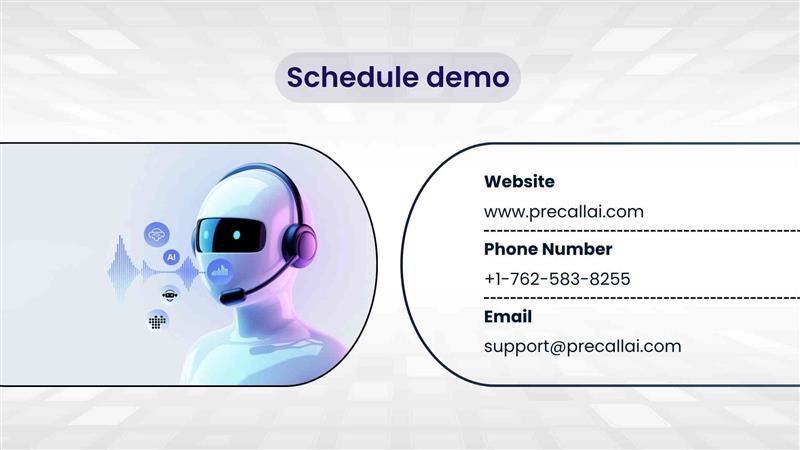
No-code voice bot platforms revolutionize phone automation for businesses everywhere. Technical barriers no longer prevent small businesses from implementing voice automation. Professional results happen without expensive development resources.
The technology empowers anyone to create sophisticated voice bots. Customer service improves while operational costs decrease significantly. Competitive advantages emerge through better customer experiences.


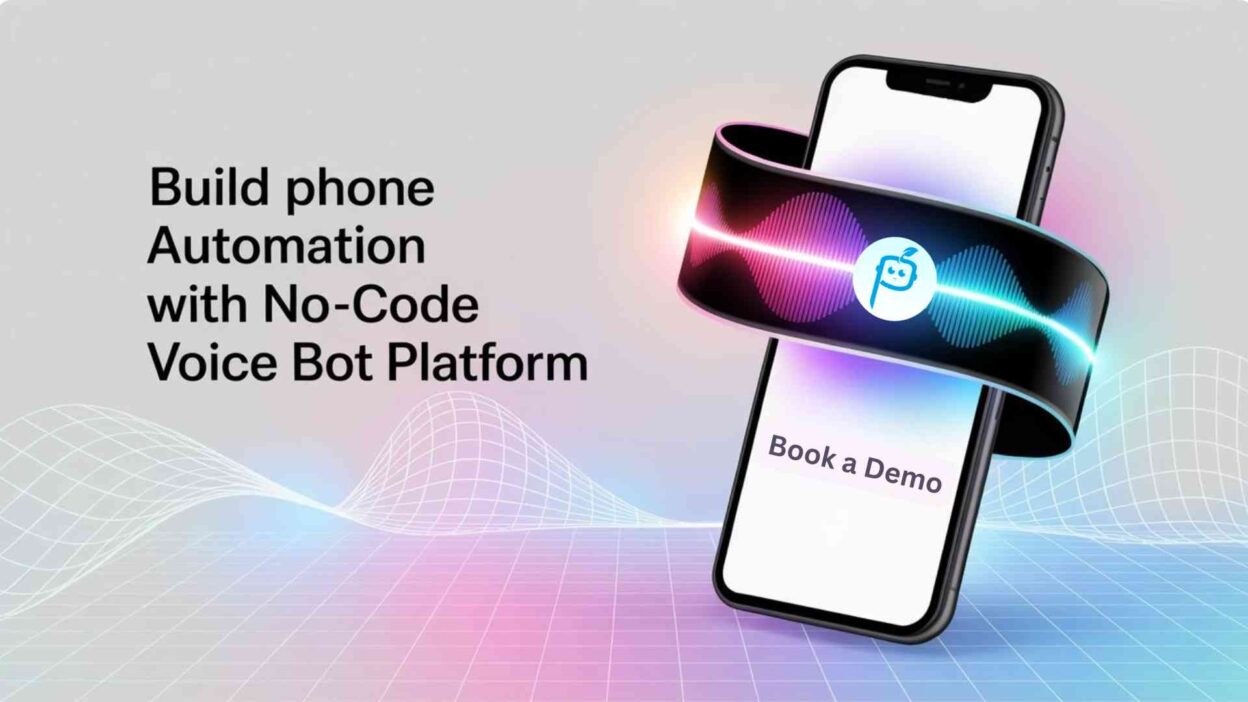
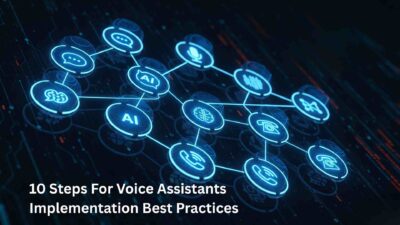
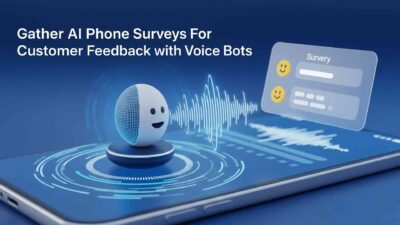
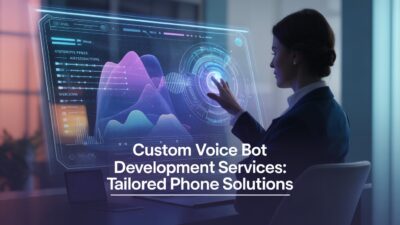
[…] Read More: Build Phone Automation With No-Code Voice Bot Platform […]
[…] Read More: Build Phone Automation With No-Code VOice Bot Platform […]
[…] voice bot white-label solution provides ready-to-deploy phone automation technology that partners can rebrand completely. The […]